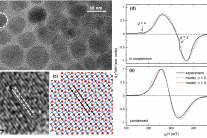Measuring the Fluctuating Magnetic Fields of Nanoparticles
Wed, 09/15/2021 - 9:17amMagnetic iron-oxide nanoparticles (NP) are important for a wide range of medical applications, and they are promising candidates for new cancer treatment methods. In a new article featured in the Journal of Applied Physics, a research effort lead by UL Lafayette Physics found that at high frequencies, the interactions between these NPs produce fields that are ten times stronger than the individual fields inside them. This finding suggests that such effects could be used to improve medical applications, which operate at high frequency.
When the size of magnetic particles becomes comparable to fundamental magnetic length scales, i.e., several nanometers, their magnetic state becomes unstable due to thermal effects and the magnetic field they produce fluctuates rapidly, in a phenomenon called superparamagnetism. In this newly published study, the team was able to measure those rapidly changing magnetic fields, and consequently observe how these particles interact with each other. By means of advanced electron-based imaging experiments [Fig. (a)], the team investigated the structure of the iron-oxide NPs down to nearly atomic resolution [Fig. (b) and (c)] and verified that they are symmetric in shape and have a diameter of 10 nm. Then, by means of ferromagnetic resonance spectroscopy, a technique which involves a microwave magnetic field at a frequency of 9 GHz, the team measured the resonance of the NPs, and by comparing the spectra with theoretical calculations [Fig. (d) and (e)], the team was able to quantify the interactions between the NPs and discover that the interaction between the NPs produces an effective field that is 10 times stronger than the fields of the individual particles. Even though conventional magnetometry techniques do not see these fields, because they have a lifetime of nanoseconds, the high-frequency experiments are able to resolve them. These findings highlight that the effects of interactions in superparamagnetic NPs should be taken into account for the design of future biomedical applications which rely on such particles for imaging at high frequencies, where the interactions become relevant and produce effective anisotropy fields which are an order of magnitude stronger than the internal fields of the particles themselves.
This article was published in the AIP Journal of Applied Physics.

